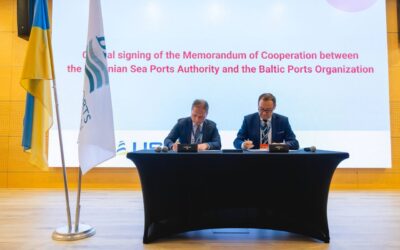Issues related to the development of critical infrastructure, energy, and high technologies were the focus of the Ukrainian-Japanese conference “Economic Growth of Ukraine. Partnership with Japan,” organised by Kyiv-Mohyla Business School [kmbs]. The event brought together representatives of the Ukrainian government, diplomatic institutions, Japanese and Ukrainian state and business sectors, international companies and financial organisations.
The Head of the “Ukrainian Sea Ports Authority” (USPA), Oleksandr Semyrga, presented the strategic vision for post-war recovery and development of maritime logistics.
“We clearly distinguish between two dimensions of our work. The first is ensuring the continuous operation of ports under wartime conditions. The second is strategic: forming a systematic vision for the recovery and development of the industry. We have identified three key areas: the renewal and modernisation of port infrastructure, digitalisation, and investment attraction. We are confident that this triad — operational stability, technological upgrade and a partnership model — will enable Ukrainian ports not only to recover, but also to reach a new level of competitiveness,” said the Head of the USPA.
Oleksandr Semyrga emphasised the importance of full digitalisation and ensuring maximum transparency of procedures in Ukrainian seaports.
“The deployment of the DocPort system is not just the implementation of a digital solution. We are changing the logic of interaction in the port: instead of “manual”, fragmented procedures, there is a single transparent platform. We are creating infrastructure that promotes speed, transparency and trust. For example, in ports where DocPort has already been implemented — Reni, Izmail, Chornomorsk and Odesa — electronic passes have reduced vehicle processing time from 24 hours to one minute, and the time for dispatching transport from 10–15 minutes to one,” he said.
The next stage of digital transformation will be the launch of the Maritime Module in the port of Pivdennyi, scheduled for June–July 2025. The new functionality will enable full electronic data exchange between maritime agents and shore services, further increasing the speed and convenience of processing ship calls in a “single window” format.The conference also highlighted cooperation between the USPA and the Japan International Cooperation Agency (JICA), which provided technical assistance amounting to over 2.4 million USD. In particular, diesel generators, pilot boats, loading equipment and equipment for eliminating emergency spills in port water areas have already been delivered to Ukrainian ports.
Another key topic discussed was the expansion of logistics routes between Ukraine and Asian countries. This direction is an important component of Ukraine’s transport potential and integration into Asian transport corridors.
The Head of the USPA paid particular attention to the fleet renewal programme, noting that a significant part of the fleet is technically and physically obsolete, which complicates its operation and maintenance, especially under wartime conditions.
“Our technical fleet is critically worn out — more than 65% of the vessels were manufactured before 1990 in the Soviet Union. The issue is not only the outdated equipment, but also the limited maintenance possibilities, especially under wartime conditions. Therefore, fleet renewal is essential for ensuring both current functionality and the future capability of the port system,” emphasised Oleksandr Semyrga.






